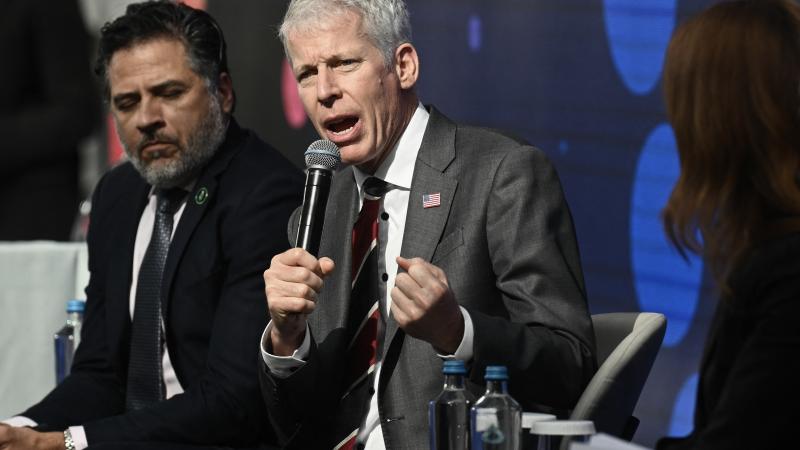Four most productive oil, natural gas counties in America are in west Texas
Unlike other states, the majority of Texas production is on private land.
The counties that produce the most oil and natural gas in all of America are in the Permian Basin in west Texas and southeastern New Mexico.
Four of the top five Texas counties that produced the most crude oil in June were in the Permian Basin: Midland, Martin, Upton, and Howard, according to the latest data from the Texas Railroad Commission, which regulates the oil and natural gas industry.
Karnes County, southeast of San Antonio, located in the Eagle Ford Shale, produced the fifth-greatest amount of crude and fourth-greatest amount of natural gas.
Statewide crude oil production totaled 109,053,025 barrels in June, with an average daily production of 3,635,101 barrels. Statewide natural gas production totaled 904,389,540 mcf (thousand cubic feet), with an average daily production of 30,146,318 mcf, according to RRC data. Midland County produced 17,721,299 barrels of crude oil and 65,341,364 mcf of natural gas.
The Texas Railroad Commission, created in 1891 to oversee the railroad industry, now regulates the $7 trillion Texas energy industry. It has both state and federal regulatory and enforcement responsibilities, regulating the industries of oil and natural gas, pipelines, coal and uranium surface mining operations.
Unlike other states where oil and natural gas companies operate on federal land and are beholden to federal leasing policies, the majority of Texas production is on private land. The Commission prioritizes issuing permits and enforcing safety regulations.
As part of the Biden administration's stated plan to eliminate fossil fuels, it continues to halt or slowwalk federal permit and lease approvals. By contrast, in August, the RRC issued 820 original drilling permits. It also processed 876 oil permits, 264 natural gas permits and 399 permits for injection completions for new drills, re-entries and re-completions. It also assessed $2,335,764 in fines last month for companies that failed to appear at enforcement proceedings and/or to comply with state regulations.
As companies in the Permian Basin have increased production, they have also decreased methane emissions. Methane emissions intensity in the Permian Basin fell by more than 76% as production increased by over 345%, according to a recent analysis. Overall, the U.S. oil and natural gas industry has made "accelerated progress in emissions reductions," according to another recent analysis.
This wasn't always the case, industry experts note. Previously, the U.S. depended on foreign oil production for decades. Long gas lines and record inflation were one hallmark of the Carter administration. After years of ingenuity and technological advancements developed by the U.S. oil and gas industry, by 2018, the U.S. became a net exporter of petroleum for the first time in 75 years. It also became a net exporter of natural gas in 2016 for the first time in 60 years.
In the first half of 2022, the U.S. became the world's largest liquid natural gas exporter, led by Texas. This year, the U.S. remained the top exporter of liquified natural gas, led by Gulf states and petroleum products exports set a new record.
Gross natural gas withdrawals from the Permian Basin set an annual record high last year, reaching 21 billion cubic feet per day (Bcf/d), the U.S. Energy Information Association reported.
Within a year of enacted Biden administration energy policies, the U.S. returned to record high gas prices and inflation, critics argue, and OPEC+ countries wouldn't or couldn't increase oil production to lower prices at the pump. Bloomberg News asked last year, "Where can the world quickly turn to for more oil? The answer, it turns out, isn't the traditional powerhouse of OPEC or the promising new offshore fields of Brazil. Instead, the weight of the oil world is falling squarely on the shoulders of a few counties tucked into lonely corners of the U.S. Southwest."
It concluded, "the global oil market hinges on fives U.S. counties"— three in west Texas and two in New Mexico—all located in the Permian Basin.
The Texas oil and natural gas already understands this, industry leaders, Gov. Greg Abbott, Sen. Ted Cruz, and others, have argued. Todd Staples, president of the Texas Oil & Gas Association, told The Center Square, "oil and natural gas are indispensable components of daily life, as 96% of the products we use have a component of oil or natural gas as the basic building block. Policy can promote prosperity, or it can hinder it. We need sound policy in Washington that treats oil and natural gas as an asset, not a liability. By fostering policies that lessen America's dependence on foreign-produced resources and encourage increased domestic investment and production, we can create jobs here at home, grow our economy, and keep the United States as the world's energy leader."
If Texas were its own country, it would be the world's third-largest producer of natural gas and fourth-largest producer of oil—led by output from the Permian Basin.
Gov. Abbott has vowed to protect the industry from "California-style restrictions on engines or fuel sources." He's also fought against the Biden administration's "ESG fanaticism," "overly aggressive Environmental Protection Agency," and "favoring foreign oil" over American-made energy. Earlier this year, he warned President Biden that any attempt to put the Texas oil and gas workers' "livelihood at risk will have a fight on their hands down in Texas."
















